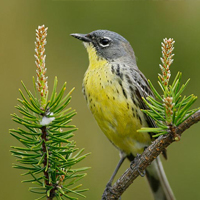Kirtland’s warbler
Scientific name: Setophaga kirtlandii

Cover photo credit: Brian E. Small
Status
Endangered
“Endangered” means the species lives in the wild in Ontario but is facing imminent extinction or extirpation.
Date added to the Species at Risk in Ontario List
The Kirtland’s warbler was already assessed as Endangered when the Endangered Species Act took effect in 2008.
What it looks like
Kirtland’s Warbler is a medium-sized songbird at approximately 15 centimetres in length. Males have yellow bellies with dark streaking along the flanks and sides.
Their upperparts are blue-grey with dark streaks and they have black cheeks and white eye rings.
Females and young look similar, but are not as boldly or brightly marked and have brownish highlights on the wings and back.
Its song – an explosive series of sharp notes – can be heard over 400 metres away in good conditions.
Where it lives
Kirtland’s Warblers have very specific habitat requirements, typically nesting in well-drained sandy soils covered in large forests of young jack pine, a habitat often created by fire.
They lay their nests on the ground, hidden away under low living branches of young jack pines with a thick cover of understory plants, such as grasses, sweet-fern and blueberry.
Mature pines that no longer have branches near the ground do not provide sufficient cover.
Where it’s been found in Ontario
Kirtland’s Warblers primarily breed in central Michigan and migrate to the Bahamas for winter.
A few are seen annually at Point Pelee National Park and other migration hotspots in southwestern Ontario, and they have long been suspected of occasional nesting in Ontario, in pockets of suitable habitat.
To date, breeding evidence has been acquired at only two sites, the most recent being in 2007 at Canadian Forces Base Petawawa.
View a Larger version of this map (PDF)
What threatens it
The main threat to Kirtland’s Warbler is the limited availability of suitable habitat. Forest fire prevention and suppression, and development over the past century have reduced the amount of suitable jack pine forest.
Active management to maintain enough of this habitat is needed for this species to survive.
Nest parasitism by Brown-headed Cowbirds, which lay their eggs in other bird’s nests at the expense of the host’s young, has also been identified as a threat.
Action we are taking
Endangered Species and their general habitat are automatically protected.
Recovery strategy
A recovery strategy advises the ministry on ways to ensure healthy numbers of the species return to Ontario.
Read the recovery strategy (December 14, 2016)
Government response statement
A government response statement outlines the actions the government intends to take or support to help recover the species.
Read the government response statement (September 12, 2017)
Review of progress
A review of progress made toward protecting and recovering a species is required no later than the time specified in the species’ government response statement, or not later than five years after the government response statement is published if no time is specified.
Read the report on progress towards the protection and recovery of 12 species at risk, including Kirtland’s warbler (2022).
Habitat protection
General habitat protection - June 30, 2008
What you can do
Report a sighting
- Report a sighting of an endangered animal or plant to the Natural Heritage Information Centre. Photographs with specific locations or mapping coordinates are always helpful.
- Bird Studies Canada is working to advance the understanding, appreciation and conservation of wild birds and their habitat in Ontario and elsewhere; for more information on how you can help visit:
www.bsc-eoc.org.
Volunteer
Volunteer with your local nature club or provincial park to participate in surveys or stewardship work focused on species at risk.
Be a good steward
Private land owners have a very important role to play in species recovery. If you find a Kirtland’s Warbler on your land, you may be eligible for stewardship programs that support the protection and recovery of species at risk and their habitats.
Report illegal activity
Report any illegal activity related to plants and wildlife to
Quick facts
- The breeding range of this warbler is one of the smallest of any North American bird; they nest almost exclusively in a small number of counties in central Michigan.
- Fire plays a very important role in maintaining the forest habitat of Kirtland’s Warbler; at first glance, it may appear that a fire has destroyed the forest, but it is the heat from the fire that is needed to open the hard jack pine. cones and start the process all over again.
- Kirtland’s Warbler is one of only a few warblers that have the distinctive habit of regularly pumping its tail up and down.
- This species feeds on blueberries and on insects, such as spittlebugs, aphids and ants.
